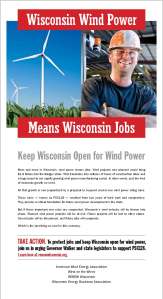From an article by Tom Content in the Milwaukee Journal Sentinel:
Wisconsin's first solar panel factory has opened in the Menomonee River Valley, on the site of stockyards that contributed to the city's leadership in the meatpacking and processing industries more than 100 years ago.
Later this year, solar panels will go up on the roof of the building that replaced the stockyards, and the panels will be made downstairs in Steve Ostrenga's factory.
Privately held Helios USA started making robots this month, using an automated production line to build high-efficiency solar panels. The goal: to help put an emerging, 21st-century industry on the map in the state.
That's what excited Patrick Shaw of Cudahy about working at the plant, he said during a recent tour of the W. Canal St. factory.
"I wanted to get into the green field," said Shaw, a former Marine. "All you hear about is how that's up and coming." Then he attended a veterans job fair where Helios was recruiting employees.
"Six months later, here I am," Shaw said.
Production started this month after five weeks of 12-hour days getting the first manufacturing line ready.
Workers installed robots that largely automate the manufacturing process and began test production earlier this month. Finished panels sit in stacks in an area of the plant where future production lines are planned.
A ribbon-cutting at the plant is scheduled for Monday.
During the plant tour, Shaw showed pride in having helped set up the robots.
"They said people's kids could name the robots," Shaw said. Pointing to one hoisting a nearly complete panel, he added, "My 4-year-old named that one Buzz Lightyear."
Shaw is one of 17 workers who, after working to open the plant, began operating its first production line two weeks ago. Ostrenga hopes to nearly triple employment by the end of the year.
Wisconsin's first solar panel factory has opened in the Menomonee River Valley, on the site of stockyards that contributed to the city's leadership in the meatpacking and processing industries more than 100 years ago.
Later this year, solar panels will go up on the roof of the building that replaced the stockyards, and the panels will be made downstairs in Steve Ostrenga's factory.
Privately held Helios USA started making robots this month, using an automated production line to build high-efficiency solar panels. The goal: to help put an emerging, 21st-century industry on the map in the state.
That's what excited Patrick Shaw of Cudahy about working at the plant, he said during a recent tour of the W. Canal St. factory.
"I wanted to get into the green field," said Shaw, a former Marine. "All you hear about is how that's up and coming." Then he attended a veterans job fair where Helios was recruiting employees.
"Six months later, here I am," Shaw said.
Production started this month after five weeks of 12-hour days getting the first manufacturing line ready.
Workers installed robots that largely automate the manufacturing process and began test production earlier this month. Finished panels sit in stacks in an area of the plant where future production lines are planned.
A ribbon-cutting at the plant is scheduled for Monday.
During the plant tour, Shaw showed pride in having helped set up the robots.
"They said people's kids could name the robots," Shaw said. Pointing to one hoisting a nearly complete panel, he added, "My 4-year-old named that one Buzz Lightyear."
Shaw is one of 17 workers who, after working to open the plant, began operating its first production line two weeks ago. Ostrenga hopes to nearly triple employment by the end of the year.

 7:42 AM
7:42 AM
 Unknown
Unknown



